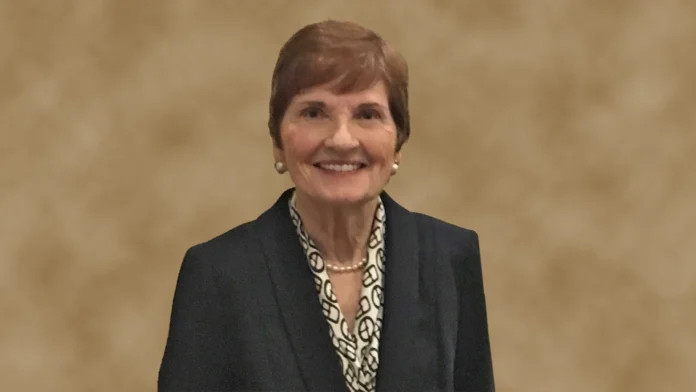Prof. Carol J. Baker is a renowned clinician, researcher, educator, and vaccinologist, internationally recognized for her pioneering contributions to pediatric infectious diseases and vaccine policy. A professor of pediatrics and molecular virology and microbiology at Baylor College of Medicine in Houston, Texas, she led the Section of Infectious Diseases in the Department of Pediatrics for 25 years.
Often referred to as the “Godmother of Group B Strep Prevention,” Prof. Baker’s groundbreaking research established the connection between maternal immunity and neonatal group B streptococcal (GBS) disease. Her early 1990s advocacy was instrumental in the adoption of intrapartum antibiotic prophylaxis, which led to an 80% decline in early-onset GBS infections in U.S. newborns. She remains a leading voice in the development of maternal immunization strategies, with vaccine candidates now in clinical trials.
Prof. Baker is a past chair of the Center for Disease Control and Prevention’s (CDC) Advisory Committee on Immunization Practices (ACIP) and a former president of both the Infectious Diseases Society of America (IDSA) and the National Foundation for Infectious Diseases. Her long-standing involvement with the American Academy of Pediatrics Committee on Infectious Diseases (1998–2012), along with her leadership at the CDC, played a pivotal role in expanding vaccination guidelines for pregnant women and young children.
A prolific author, Prof. Baker has published more than 400 scientific articles, reviews, and book chapters. She also served as associate editor for several editions of the Red Book, a definitive resource in pediatric infectious diseases. Among her many honors are the Distinguished Physician Award and Distinguished Service Award from the Pediatric Infectious Diseases Society, the IDSA Mentor Award and Society Citation, and the Distinguished Alumna Award from Baylor College of Medicine.
Prof. Baker’s career exemplifies the profound impact of uniting rigorous science with unwavering advocacy. Her work continues to shape the future of maternal and child health across the globe.
Origins and inspiration
A lifelong dedication to medicine—specializing in pediatrics, infectious diseases, and ultimately vaccines—led Prof. Baker to groundbreaking discoveries about the link between infant group B streptococcal (GBS) disease and maternal immunity. Her scientific insights, combined with steadfast advocacy for maternal immunization, have transformed neonatal care.
“All I ever wanted to do was to help the most vulnerable in our population: babies,” she reflects.
Group B Streptococcus is carried asymptomatically by approximately one in four healthy pregnant women. Yet, for newborns, it can result in invasive infections with severe complications, including deafness, blindness, or developmental disabilities caused by meningitis.
Born in Southern California to a physician father and a mother who had been a pre-med student, at a time when women rarely pursued medical careers, Prof. Baker was immersed early in a love of science and medicine. By age six, she had already declared her ambition to become a doctor. For her birthday, she received a toy doctor kit and a kitten, George, her first patient.
“And I never changed my mind,” she shares. “So, what led me to pediatrics? Process of elimination.”
Her path into infectious diseases stemmed from strong clinical training and hands-on experience. In 1965, during a major rubella epidemic that had swept through Houston and much of the South, Prof. Baker was involved in caring for newborns affected by congenital rubella syndrome. One of her responsibilities was performing femoral vein punctures to collect blood samples from these infants, samples that contributed to numerous scientific papers on the syndrome.
“That’s where I learned that the mothers were fine, but that this was something that could be passed to the baby, and we don’t have this disease anymore,” she shares because the Measles/Mumps/Rubella (MMR) vaccine.”
Group B Streptococcal disease
Prof. Baker’s journey into the world of Group B Streptococcus (GBS) began during her pediatric residency at a large county hospital, where she encountered a severely ill newborn -just three or four weeks old- diagnosed with bacterial meningitis. According to the textbooks, it should have been cause by E. coli. But something didn’t sit right. The hospital lab reported that Enterococcus grew from the cerebral spinal fluid (CSF).
Confident she had identified the true culprit, Prof. Baker attempted to share her findings with various medical faculty. But as a young resident with limited experience, her concerns were repeatedly dismissed. Frustrated yet undeterred, she began visiting the microbiology lab to retrieve blood agar plates from babies diagnosed with meningitis. She carefully sealed and stored them in her apartment. Eventually, she had collected 13 samples.
Determined to find answers, she reached out to Dr. Rebecca Lancefield, the legendary microbiologist known for her work in Streptococcal classification at the Rockefeller Institute for Medical Research. To Prof. Baker’s surprise, Lancefield wrote back and requested Baker’s strains.
That bold move marked the beginning of a pivotal moment in her career. Dr. Lancefield, who would become one of her earliest and most influential mentors, invited Prof. Baker to spend six weeks at the Rockefeller Institute. Eager to prepare, she bought a book on immunochemistry and never looked back. Her love for children carried her throughout her proliferous career.
GBS vaccine for pregnant women
In the 1970s and ’80s, the only maternal vaccine recommended by the U.S. Public Health Service was for influenza. Although the science and manufacturing capacity to develop a Group B Streptococcus (GBS) vaccine existed as early as the 1990s, widespread reluctance to give pregnant women “anything except water” created major barriers. Risk aversion surrounding pregnancy, often summarized as “nothing during pregnancy”, made the idea of maternal immunization difficult to advance.
Despite the challenges, Prof. Baker and her colleagues persisted. In 1992, a turning point came when a young Epidemic Intelligence Service at the Center for Disease Control and Prevention (CDC) officer, approached her (Dr. Anne Schuchat). “Well, Dr. Baker, I’ve read your work,” she said. “And my boss and I think that GBS in young infants is a serious public health problem.” Working with professional organizations in pediatrics and obstetrics, Drs. Schuchat and Baker developed guidelines for pregnant women carrying GBS.
Four years later, in 1996, the CDC issued its first recommendations to prevent early-onset GBS disease in newborns. The guidelines included routine assessment of pregnant women for GBS and in 2002, this becomes culture screening and intrapartum antibiotic prophylaxis with intravenous penicillin—a major public health milestone largely shaped by Prof. Baker’s advocacy and research.
A decade later, in early 2010, the U.S. faced a resurgence of whooping cough (pertussis), due in part to waning immunity from childhood vaccinations. The resulting outbreaks led to the deaths of several young infants and captured national attention, making front-page headlines and prompting urgent action from the CDC’s ACIP.
“I was ACIP chair,” Prof. Baker recalls. “It was 2011 and, at that time, we had the Tdap vaccine—tetanus toxoid, reduced diphtheria toxoid, and acellular pertussis for use in adolescents. The whole discussion of these outbreaks and a way to prevent them led to use of Tdap in pregnant women.” After much debate centering on the lack of safety data versus the likelihood that vaccinating pregnant women could protect the baby through maternal antibodies, the ACIP recommendation routine Tdap vaccination during pregnancy. “There was no other way to prevent it,” she says. “So, the recommendation became reality.” There outbreaks of pertussis ceased and this recommendation persists continue.
Today, maternal vaccination is a proven, life-saving strategy for influenza, pertussis and COVID. Still, Prof. Baker notes with concern the recent decline in vaccination rates driven largely by the increased perception of risk.
Safety concerns in pregnant women
For decades, there was a pervasive concern that virtually anything introduced during pregnancy might pose a risk. At one point, the FDA explicitly prohibited the inclusion of pregnant women in vaccine trials, driven by a highly risk-averse mindset. However, as more pregnant women and newborns began dying from preventable diseases like influenza, pressure grew to reevaluate this stance, especially regarding the flu vaccine.
The 2009 H1N1 pandemic was a pivotal moment. The urgent need for protection pushed flu vaccination in pregnancy into the spotlight. Once it became routinely recommended, systems were in place to collect safety and efficacy data, helping to reinforce public confidence.
Prof. Baker believes that improving education and communication, and removing political interference, is essential to restoring public trust in vaccines and in healthcare providers.
The scientific consensus is clear: the development of vaccines remains the greatest and most cost-effective medical achievement of the 20th century. But, as Prof. Baker highlights, vaccines alone are not enough. She reminds us that access and trust are vital in the success of this journey. Because science can create remarkable vaccines that could very well sit in a bottle.
“This escalating distrust in science, what spills into the trust we’ve had for decades in the patient, doctor, or nurse relationship. The intrusion of this distrust into the ecosystem of vaccines -every little piece of it- is going to take the progress that we’ve made, and the protection we’ve had, away from us if we let it happen. And it’s happening,” she concludes with a sobering reflection on the erosion of public confidence.







